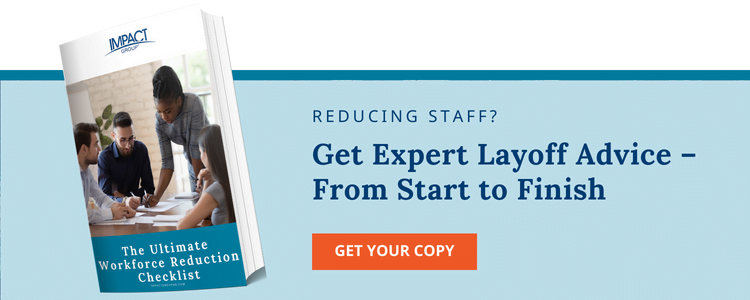Have you compared the California WARN law with the federal WARN statute? HR professionals should be reminded that each state has its own regulations affecting layoffs. Whether you employ workers in California or not, the California WARN law should be on your radar for a couple of reasons. First, the California WARN law is a bit more stringent for employers than the federal version. Second, it’s often said that, as California employment law goes, so goes the nation.
WARN Act Overview – Requires 60 Days’ Advance Notice
- Here’s a basic review of the federal Worker Adjustment and Retraining Notification Act (WARN).
- Employers must give employees 60 days’ notice of a plant closing or mass layoff.
- It applies to employers that employ 100 or more full-time employees. Or, 100 or more employees – including part-time – that together work at least 4,000 hours per week.
- The term “plant closing” means the permanent or temporary shutdown of a single site of employment, or a group within a single site of employment, if the shutdown results in job loss for at least 50 full-time employees within a 30-day period.
- The term plant closing can apply if the above criteria are met even if a few employees remain.
- A “mass layoff” is employment loss at the single site of employment during any 30-day period for:
- A layoff of at least 50 employees that represent at least 33% of the active employees, excluding part-timers, or
- A layoff of 500 or more full-time employees.
California WARN Law – A Bit More Stringent for Employers
The California WARN law has two significant differences from the federal version. (1) It affects employers with just 75 employees (rather than 100), and a layoff of 50 people counts as a mass layoff – no matter what percentage of the total head count.
Layoffs are Up in California
Layoff activity in 2023 appears to be returning to pre-Covid levels, based on data collected through July by the U.S. Bureau of Labor. In 2020, the U.S. experienced a surge in layoffs coinciding with the global pandemic, then layoffs were relatively light in 2021.
With nearly 1,200 filings, California leads the country in WARN filings so far in 2023, according to Warntracker.com. The next closest state is New York with 350 WARN filings.

Poorly Executed Layoffs Energize Legislators
In California, legislators sought to strengthen the state’s laws protecting employees from surprise layoffs. However, Governor Newsom vetoed the legislation that would have required 75 days’ advance notice – rather than 60 days – in the event of a mass layoff, closure, or relocation.
This proposed legislation was likely inspired by sweeping layoffs at major tech companies operating in California. According to the LA Times, the unusual handling of layoffs at Twitter provided impetus for stronger legislation favoring workers. Twitter has been involved in several lawsuits after it laid off more than half of its workforce as a cost-cutting measure in October 2022.
At the federal level, U.S. Senator Patty Murray and Senator Sherrod Brown introduced the Fair Warning Act in late 2023. This legislation would update the WARN Act to ensure that workers and their communities get a fair warning when they are going to be affected by layoffs or business closures. U.S. Senators Bernie Sanders and Elizabeth Warren are cosponsors of the bill. U.S. Representatives Emilia Sykes, David Trone, and Nikki Budzinski introduced the House version of the bill, however it is unclear whether these bills will be enacted into law.

Does California Lead the Country in Employment Law?
California has a history of being the first to pass important workplace legislation that’s eventually adopted nationwide. As an example, California first passed an Equal Pay Act in 1949. In 1963, John Kennedy signed similar legislation recognizing that women’s work—and their fair and equal treatment in the workplace—is vital to our country’s economic prosperity.
Some national employers with significant concentrations of employees in California choose to abide by California’s employment standards companywide rather than offer varied policies for their employees.
What are the Penalties of the California WARN Law?
An employer that violates the California WARN law provisions is liable to each employee for an amount equal to back pay and benefits for the period of the violation, up to 60 days, but no more than half the number of days the employee was employed by the employer.
Who Enforces WARN?
The federal WARN Act is enforced by the courts. Often employees file lawsuits with the U.S. District Court for any district in which the violation is alleged to have occurred or in which the employer transacts business. The U.S. Department of Labor doesn’t prosecute employers, but it has a role in providing information and can advise the courts; however, the courts are not obliged to accept any guidance.
Next Steps for HR & Talent Leaders
1. Retain an outplacement firm. This will lower your legal risk, maintain surviving employee engagement, and minimize your unemployment costs. Outplacement coaches work with separated employees to help them with the emotions of job loss and help them transition successfully. This successful and expedient transition helps mitigate legal risk and protects your employer brand. And finally, by working with an outplacement firm such as IMPACT Group, you can better control your unemployment insurance costs. That’s because those working with professional outplacement coaches are likely to move into a new job faster. The less time employees collect unemployment, the lower your insurance “experience rate.” And that lower rate helps you maintain a lower unemployment tax rate.
2. Seek out legal advice. If your organization is planning a worksite closure or layoff, get good advice and be prepared to follow federal and state laws. You can find a wealth of information online, but this information is no substitute for advice from legal professionals.
3. Get IMPACT Group’s Ultimate Workforce Reduction Checklist. You will find several checklists that address every stage of the layoff in this one, complete guide. Get your copy here: https://impactgrouphr.com/business/checklist/workforce-reduction/










